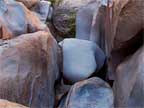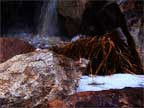In the space-time continuum of things, there exists in theory the possibility that time is almost irrelevant; that things do not necessarily happen in the manner in which we have come to believe. For example, we know that a nearly infinite number of objects exist in outer space, and we strongly suspect that gravity slows time down, so that the time between these objects is moving at a faster rate than the time at these objects. As Einstein said, "Time is relative". Fascinating.
That gives me permission to present this journal in a manner that feels right, rather than in a strictly chronological order. I have put things in order where possible but sometimes I just need to talk about something else that may have occurred in a different time and place. Of course a good example is this paragraph; though it appears first, it was written last. (I love that freedom.)
The Waterfall

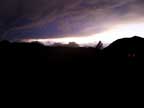
On January 18, 2010 it rained 0.78 inches; not much, ¾ of an inch. It was the first real rain in over five weeks, though there had been a few light sprinklings mid December. This 3.5 hour rain on a cool Thursday afternoon washed five weeks of dust from our solar panels, home and car. It soaked the ground. A subsequent light breeze evaporated some of that from the surface.
The next day, Friday, it rained 0.53 inches in the afternoon over a period of 4 hours. This got the ground wet again and there were puddles on the dirt road. The skies remained cloudy for much of these two days, so the panels found little sun available to charge the battery bank.

On Saturday the 20th, the sun came out for awhile and I could hear the welcome hums and clicks of the inverter as it absorbed power from the panels and fed it to the batteries. The trucker delivering our new compost toilet did not want to chance getting stuck on the wet roads, so I drove out to the highway to meet him. We transferred the big carton to the open hatch of my Prius and I gently transported it back to our home. That afternoon it rained another 0.70 inches, and that lasted for about six hours, stopping around 9:00 PM.
It may have stopped, but the ground was wet. The soil on any slope is generally shallow or bare, as opposed to that in the washes like the one that comes out of the hill above and runs by our place. Sediment in the wash has been accumulating for eons, having washed down the hillside. Hence that on the hillside is minimal and does not hold a lot of water. At some point the rain stops soaking in and it begins to flow sideways, like a wet sponge that will not absorb any more water. Likewise, that wet sponge will continue to drain long after the water is turned off.
At any given point this process is almost invisible, but the water that hits the wet soil, caliche and rock is now moving away towards whatever direction happens to be down. The holes and depressions in the rock become small pools that the coyotes, cats, rodents and birds can drink from. This quiet accumulation of flow from all directions finds its inevitable way to a common rocky prominent cleavage in the hillside where there is no soil; only round smooth polished stone, and here the flow becomes visible. The animals know better than to enter this place. The insignificant flows that trickle in from the surrounding terrain will gradually and suddenly become significant surges of water gaining in volume and speed and ferocity as they come together and rush downward.
Around midnight I began to hear it. Though the rain had stopped three hours before, I could hear the faint distant sound of falling water. I was on my computer at the time. I got out of my chair, pocketed my camera and flashlight, walked out the door and began to move up and across the rocks that overlook the little house, careful because they were wet and dark. I was quietly excited. Up in the dark hill above, I could hear a sound that I had never heard before in this place.
Further along towards the head of our wash where it turns into the hill that it emanates from, I began to see moving water in the light of my flashlight flowing beneath and around the rocks that I was standing on. I climbed, ascending the hill beside the flow; not over it. The rocks are fairly rough and easy to grip with the soles of climbing shoes, but those over and in the flow I knew to be smooth.
I had climbed this area many times in the past marveling at the almost mysterious shapes and contours left behind by powerful flows that had occurred in centuries and millenniums past.
The sound of falling water became louder and closer as I approached the cleft that I knew it would be falling through. As I reached the top of the slope below the cliff of extreme boulders and could feel a mist landing on my skin, I stopped and shined my light up into the darkness above. I saw a waterfall in front of me, or rather a number of narrow falls flowing out of the rocks above and down into a foaming pool at my feet.
Here it was. I had wondered about this quiet spectacle for forty years. Now I was seeing it, in awe, and yet anticipating that tomorrow there would be even more. In time I realized that I had better return home and get some sleep. I did so, reluctantly. I woke Eileen to tell her about it. We stood on the deck for awhile and listened, and then we went to bed.
It began to rain again about 4:00 AM, now Sunday the 21st of January. This time it rained throughout the day, stopping around 5:30 in the afternoon for 2 hours so that we could climb the hill in daylight and get some pictures. This is also when I learned how to use the video function of my camera, wishing that I had taught myself back before I needed it. It rained lightly into the next day, Monday, stopping finally about 11:00 AM.
I uploaded one of those videos to
my Facebook page.
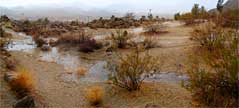
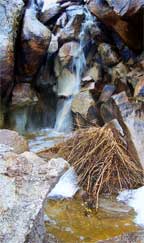 On Sunday it had rained 1.49 inches and on Monday another 0.42 inches. The total for the 4 days was almost 4 inches; not much, but a lot. We lost our power that Sunday morning at about 8:30 AM; the batteries were drained. We ate dinner in town that night. The power returned the next day at about noon. The roads had been washed out but were negotiable. Within a few days the Monument Manor Homeowners Association was bringing in numerous loads of fill and a front loader put the roads back into better shape than I had ever seen them. I sent them a check for $100.
On Sunday it had rained 1.49 inches and on Monday another 0.42 inches. The total for the 4 days was almost 4 inches; not much, but a lot. We lost our power that Sunday morning at about 8:30 AM; the batteries were drained. We ate dinner in town that night. The power returned the next day at about noon. The roads had been washed out but were negotiable. Within a few days the Monument Manor Homeowners Association was bringing in numerous loads of fill and a front loader put the roads back into better shape than I had ever seen them. I sent them a check for $100.
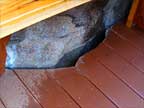
It broke the wall of my new shower stall, snapping a horizontal brace that had tied the vertical boards together. However, the rest of the frame continued to hold it in place. A large boulder adjacent to the wash had settled and rolled outward about 3 inches. I had shaped the floor to fit into the contours of the rock wall a year ago. Now there was a 3" gap between the floor and the boulder. It remains as such - for now.
On Wednesday the 24th we went for a long walk to follow the wash that begins at our place. Across the street it meanders down and becomes a small head-high canyon. It is joined by other washes along the way. It cuts between some cabins that somebody had built a few decades ago, now owned by our neighbor Bill Bolster. It widens around the new adobe that was built over the wash a few years ago, though it looks like their place stayed dry.
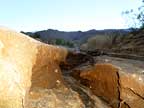
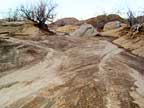
It travels through a maze of small canyons hiding the remnants of a long abandoned campsite that may have once been a squatter's home decades ago. About a mile down the gradual slope of the valley it flows around the curve of another hill, to parallel the Quail Springs Highway but far enough in to bypass a stable and another home, and ends as a wide shallow riverbed, giving evidence of having carried a raging violent deluge 3 days before.
It rained some again in February and a bit in March and April, but not anything near enough to generate another waterfall and stream through our wash. Though I shot off enough pictures and videos to know when the sun shined, I did not record the numbers that were specified in this story. I obtained those readings from
The Weather Underground which had compiled the work of a dedicated enthusiast somewhere on the opposite side of our valley, along with the same from like minded 'weather stations' around the high desert and in fact across the nation. They also provide an informative graphic image and forecast of the weather across the nation, which I keep my eye on prior to, and sometimes during, our 3000 mile trips across the country. It helps me avoid ice & snow on the trip west, and tornadoes & floods on the flip-side.
The Trip West, Thank God For The GPS - But Not Tolls
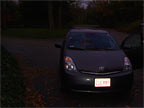
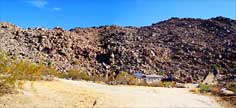
We left the Cape before daybreak on Saturday October 31, arriving in Joshua Tree on Wednesday November 4th before noon. We stayed in:
Mechanicsburg, PA (mile 422)
422 miles on the first day?? I usually do much better than that. The reason was that we had done a lot of driving along the back roads of Pennsylvania looking for the Amish. We actually did see one coming in the opposite direction around a curve in his horse and carriage. Eileen had just completed reading a number of books about the Amish written by a woman who had chosen to leave the fold. We never did find a community of Amish, though we saw a few of their barns. I had argued that if she had planned this ahead of time, I could have researched it online and found out exactly where to locate them. Typing "Amish" into our GPS did not turn up anything. Later we heard that we might have had better luck in Ohio. The next time she decides to go on one of these unplanned side trips, I will just say NO!
Effingham, IL (mile 1098)
Liberal, KS (mile 1848)
Williams, AZ (mile 2587)
However, I have certainly learned from experience to put my faith in my GPS; if it says to go a way that seems a bit strange, I go that way. It knows something I don't know. Around home, I usually set the GPS to take the shortest most direct route. On trips I tell it to take the fastest route, which usually means taking interstates all the way. On day 3, all seemed well through Effingham, IL and on to Wichita, KS. There, we would normally follow I-35 south around Oklahoma City to I-40 and then west.
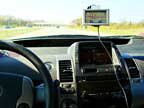
Instead, in Wichita it told us to get off of I-35 and head southwest on a local state road #54. This was a new one. But then it quickly put us up onto a brand new 4 lane highway that looked very much like a real interstate. I figured okay, we have a brand new road and the GPS has determined that it will get us there faster. That magnificent new highway sent us on our way and directly west - for about 20 miles. Then we were back on the 2 lane state road.
It was kind of interesting passing through long stretches of farmland and countless 25 MPH small farm towns and numerous traffic lights, but the GPS must know what is was doing, and we were certainly heading in the right direction, so we stayed with it. Of course, by the time you find yourself 100 miles from nowhere in all directions, you might as well keep going.
78 miles out we stopped for dinner in Pratt, KS. It was a nice old prairie railroad town with red brick buildings and a collection of contemporary shops. The town had apparently undergone a significant facelift recently and it was nicely done. We ate dinner at the Club D'Est, good food and atmosphere and the price very reasonable. We then continued on this long back road another 133 miles to the city of Liberal where we checked into a local motel. In the morning, this long hard non-interstate trek continued.
Liberal was half way on this 417 mile, 8 hour drive along Route 54, from Wichita to Tucumcari, NM. There we finally regained the interstate system. Route 54 was definitely the most direct way to go. However it was such a long long stretch of infinite slow-downs that I had come to suspect the sanity and/or integrity of that GPS system. I had a sneaky suspicion that maybe somehow some politicians had paid somebody to put Route 54 on the GPS map.
Until now - I just did the math. Route 54 is the hypotenuse of a triangle, with I-35 and I-40 being the other legs. Now this is interesting - I did not realize this until I began to type this diatribe and crunched the numbers. Those two legs add up to 532 miles which Google indicates would have taken about 8¾ hours. Route 54 was indeed the faster and shorter way to go. Amazing! Damn, I guess I could have relaxed and enjoyed it after all - if I had only known. Hey, I even saved on the Oklahoma Turnpike (I-35) tolls, and some gas.
By the way, I do hate tolls. Not so much for the money, but for the rude and unsettling, if not dangerous, interference in the smooth flow of the trip. On the return trip six months later, I went up the Oklahoma Turnpike totally unprepared. Normally I stash my quarters over time so that I will have them for the tolls (and laundry but that is no longer necessary). That in itself is a nuisance and a waste of time, especially when I bump the tray inside the center console and it drops them into the catch-all below so that I have to dig through and find them. So I hate cash too. I try to carry as little as possible in my wallet by using my cards for everything (if a store does not take cards, I do not shop there (accept for my favorite breakfast place, The Country Kitchen)). However, for some reason on this trip I did not have a stash of quarters.
When I pulled into the first Oklahoma toll booth, all I had was a $20 bill. They were thoughtful enough to provide a change machine, so $20 worth of quarters were dumped into my hands. Where do you put $20 worth of quarters where they will be easy to reach as needed when you are trying to drive through the booth without stopping, gathering the right amount of quarters without looking, and throwing them into the bin without missing (I did miss one or two, but no cops chased me down). With other anxious vehicles behind me and with my trying to watch the traffic in the adjacent lanes to avoid collisions without slowing down too much, it is an accident begging to happen. So toll booths scare the hell out of me. I can remember being very grateful when the Governor of Connecticut removed all the toll booths from I-95. It probably saved a lot of lives; maybe my own.
Meanwhile one can't help but notice that much of the traffic is speeding right through the lanes labeled "Prepaid Tolls Only". Variations of the same were repeated in subsequent states. I began to think about those non-stop fast lanes. Without thinking, I had always thought that they were a special arrangement only available to daily commuters, and then I would forgot about it until the next trip a half year later. This time I activated the part of my brain that thinks and I realized that maybe I should go online and check into this.

The end result is that I now have a little white box stuck to my windshield that will get me through almost any toll booth in the northeast and as far west as Illinois. It will automatically record my passing and debit my VISA in $20 lots, as needed. This is nice. No longer will I have to remember to get receipts or scribble a note for every toll without taking my eyes off the road, many of which I forget so I never have an accurate account of what I have paid in tolls - until now. That is no longer a problem (in the northeast) because I can go online and find out exactly what I did pay.
I have also applied for a similar box from Oklahoma and expect to have that one on my windshield before the next trip. I can see that they have already debited my card by $40. I assume I will hear from them shortly. Massachusetts makes it easy to handle this online and, after a $20 deposit, it is free. Oklahoma requires that the form be printed and mailed.
|
Copyright © 2010, Van Blakeman |
